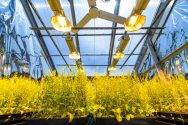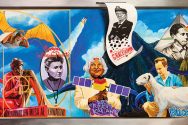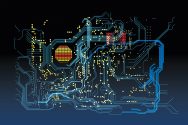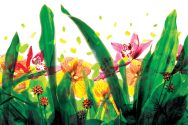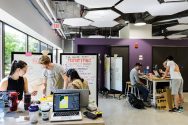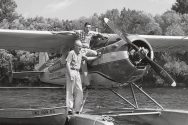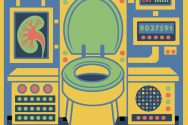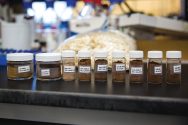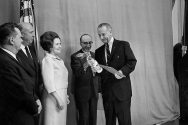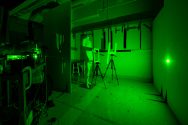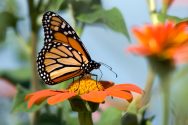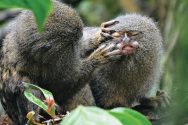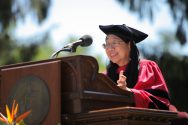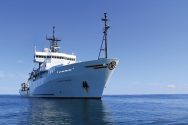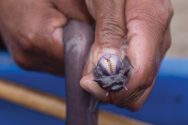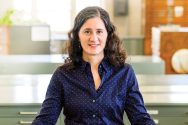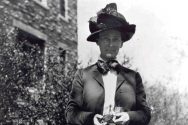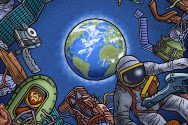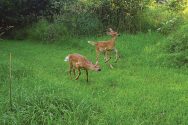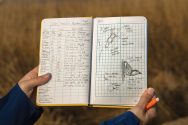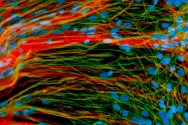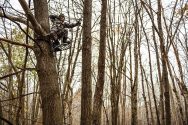UW researchers are unlocking the secrets to growing food in outer space.
Science
280 stories. Showing page 3 of 10.
An ambitious new project connects muralists and UW researchers.
A new master’s program takes computing to the next level.
Despite bleak environmental news, the UW’s Nelson Institute finds reasons to hope.
UW Makerspace puts no limits on a student’s imagination.
Arthur Hasler made UW–Madison a world-renowned hub for limnology.
New technology analyzes urine to improve your health.
UW patents a way of making Tylenol’s active ingredient from plant material.
Philanthropist Mary Lasker x1922 was one of the most influential figures in 20th-century medical research.
Volunteers develop a course to help students help themselves.
The Big Red Ball lets scientists study solar phenomena from the comfort of Earth.
It would recognize images without any power sources.
New technology can capture complex hidden scenes.
Now based at the Arboretum, Journey North marshals an army of amateur biologists.
The winners of this year’s UW Cool Science Image contest were announced in March.
Physicist Fatima Ebrahimi PhD’03 believes that if efforts to control nuclear fusion pay off, it will provide unlimited energy that will change the world.
Born in war-torn Hong Kong to a prominent but absent father and his sixth concubine, UW physicist Sau Lan Wu has overcome stunning obstacles on her path to three major scientific discoveries.
A UW–developed portable weather lab journeys to the Philippine Sea.
Experts use math to better understand a sea creature’s defense mechanism.
The #MeToo movement reaches far beyond Hollywood and Capitol Hill. The sciences are also grappling with how to address sexual harassment. This past year, the American Geophysical Union adopted a policy that added sexual harassment as a form of scientific misconduct, saying that it willfully compromises the integrity of…
Florence Bascom shows off a tool of her trade: a Brunton compass. During her work with the U.S. Geological Survey, she placed benchmarks like the one pictured below, which denoted a site’s exact elevation. Florence Bascom Papers, Smith College
There’s an apocryphal story about what set…
McCoy, pictured in her bacteriology lab in 1953, became one of the first women in science to earn a full professorship at the UW. UW Archives S08175
Bacteriologist Elizabeth McCoy ’25, PhD’29 joined the UW faculty in 1930, and in 1943, she became the second woman at the…
It’s getting mighty crowded in space as debris from satellites, labs, and other things shot into Earth’s orbit degrade over time and threaten to fall back to where they came from.
Sorbetto/ISTOCK
3D printing seems like science fiction come to life.
“It’s kind of Star Trek–like,” says Dan Thoma MS’88, PhD’92, director of the Grainger Institute for Engineering, who has researched the technology for 25 years.
Remember when Captain Picard commanded the replicator on the…
Wrestling bears, a soaring eagle, and curious fawns are among the 22 million images captured by a first-of-its-kind network of volunteer-run trail cameras in Wisconsin.
The project — called Snapshot Wisconsin — was launched in 2016 by the state’s Department of Natural Resources to monitor wildlife and to help…
Mason Muerhoff
Nomen est omen, said the ancient Romans, who liked their maxims to rhyme: one’s name is one’s destiny. And while there’s little empirical evidence about this aphorism, put Anna Pidgeon PhD’00 down on the side of support. The professor with the columbiform name has…
It’s been two decades since the first human embryonic stem cell lines were derived at UW–Madison. What effect has the discovery had on scientific research and human health?
The country’s population of whitetail deer is at record numbers, and a UW scientist’s work grapples with what that means for their environment.
Adam Steltzner PhD’99 just wanted a regular job, so he became an engineer — eventually, one of NASA’s top engineers. Now he’s helping lead the search for life on Mars.
